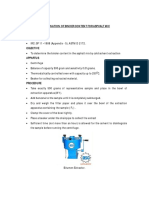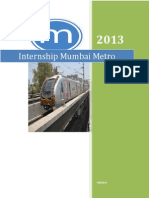Determination of In-Situ Density by Core Cutter Method: Experiment No 5 DATE
Uploaded by
11520035Determination of In-Situ Density by Core Cutter Method: Experiment No 5 DATE
Uploaded by
11520035DEPARTMENT OF CIVIL ENGG.
GCEM
EXPERIMENT NO 5 DATE: ________
DETERMINATION OF IN-SITU DENSITY BY CORE CUTTER METHOD
Aim:
To determine the field density or unit weight of soil by Core cutter method.
Field density is used in calculating the stress in the soil due to its overburden
pressure. It is needed in estimating the bearing capacity of soil foundation system,
settlement of footing, earth pressures behind the retaining walls and embankments.
Stability of natural slopes, dams, embankments and cuts is checked with the help of
density of soil. It is the density that controls the field compaction of soils. Permeability of
soils depends upon its density. Relative density of cohesionless soils is determined by
knowing the dry density of soil in natural, loosest and densest states. Void ratio, porosity
and degree of saturation need the help of density of soil.
Specifications:
This test is done to determine the in-situ dry density of soil by core cutter method
as per IS-2720-Part-29 (1975). Core cutter method in particular, is suitable for soft to
medium cohesive soils, in which the cutter can be driven. It is not possible to drive the
cutter into hard and boulder soils.
Equipments Required:
1) Cylindrical core cutter, 100mm internal diameter and 130mm long.
2) Steel dolley, 25mm high and 100mm internal diameter.
3) Steel rammer mass 9kg, overall length with the foot and staff about 900mm.
4) Balance, with an accuracy of 1g.
5) Palette knife, Straight edge, steel rule etc.
6) Square metal tray – 300mm x 300mm x 40mm.
7) Trowel.
Theory:
Field density is defined as weight per unit volume of soil mass in the field at in-
situ conditions. In the spot adjacent to that where the field density by sand replacement
method has been determined or planned, drive the core cutter using the dolly over the
core cutter. Stop ramming when the dolly is just proud of the surface. Dig out the cutter
GEOTECHNICAL ENGINEERING LAB VI SEMESTER Page 20
GCEM
DEPARTMENT OF CIVIL ENGG. GCEM
containing the soil out of the ground and trim off any solid extruding from its ends, so
that the cutter contains a volume of soil equal to its internal volume which is determined
from the dimensions of the cutter. The weight of the contained soil is found and its
moisture content determined.
Equations are;
d = t/(1+w) gm/cm³
OR d = t/(1+w) kN/m³
Where, d = dry density in g/cm3,
d = dry unit weight in g/cm3,
t = field moist density in g/cm3,
t =field moist unit weight in g/cm3,
w =water content %/100,
w = unit weight of water = 9.81 kN/m³
Precautions:
1. Core cutter method of determining the field density of soil is only suitable for fine
grained soil (Silts and clay). That is, core cutter should not be used for gravels,
boulders or any hard surface. This is because collection of undisturbed soil
sample from a coarse grained soil is difficult and hence the field properties,
including unit weight, cannot be maintained in a core sample.
2. Core cutter should be driven into the ground till the steel dolly penetrates into the
ground half way only so as to avoid compaction of the soil in the core.
3. Before lifting the core cutter, soil around the cutter should be removed to
minimize the disturbances.
4. While lifting the cutter, no soil should drop down.
Procedure:
a) Measure the height and internal diameter of the core cutter to the nearest 0.25
mm.
b) Calculate the internal volume of the core-cutter Vc in cm³.
c) Determine the weight of the clean cutter accurate to 1 g (W1 in g).
d) Select the area in the field where the density is required to be found out.
Clean and level the ground where the density is to be determined.
e) Place the dolley over the top of the core cutter and press the core cutter into the
soil mass using the rammer. Stop the pressing when about 15mm of the dolley
protrudes above the soil surface.
GEOTECHNICAL ENGINEERING LAB VI SEMESTER Page 21
GCEM
DEPARTMENT OF CIVIL ENGG. GCEM
f) Remove the soil surrounding the core cutter by digging using spade, up to the
bottom level of the cutter. Lift up the cutter and remove the dolley and trim both
sides of the cutter with knife and straight edge.
g) Clean the outside surface of the cutter and determine mass of the cutter with the
soil (W2 in g).
h) Remove the soil core from the cutter and take the representative sample in the
water content containers to determine the moisture content
i) The field test may be repeated at other places if required.
j) The water content of sample collected is determined in the laboratory as per
Experiment no 3 (Determination of water content of soil solids by Oven Drying
Method).
k) Use the above equation, given the theory section, for determining density of soil
(d OR d).
Pre-Viva Questions:
1. Out of wet density, dry density, and saturated density, which one of them is maximum
and minimum? Explain.
2. What are the main factors which affect in-situ density of soil? Explain.
3. Beside the density, what other properties do you need to calculate the void ratio and
degree of saturation of soils?
4.What are the other methods to calculate the field density of soil?
5. Which is the most accurate method to determine the field density?
Observations:
Length of core cutter l=-----------------cm
Diameter of core cutter d=--------------cm
Volume of core cutter=Vc=------------cm
GEOTECHNICAL ENGINEERING LAB VI SEMESTER Page 22
GCEM
DEPARTMENT OF CIVIL ENGG. GCEM
Table:
Table 5: Weights of core cutter
Test nos.
Sl.No. Particulars
1 (d1) 2 (d2) 3 (d3)
1. Weight of empty cutter (W1), gms
2. Weight of cutter + wet soil (W2), gms
3. Volume of core cutter (Vc) cm³
4. Weight ass of empty container (W3), gms
5. Weight of container + wet soil (W4), gms
6. Weight of container + dry soil (W5), gms
7. Water content (w)=(W4-W5)/(W5-W3)
8. Field moist density t (kN/m³) = (W2-W1)/Vc
9. Dry density d (kN/m³) = t /(1+w)
10. Average density, Avg d
Specimen calculations:
Avg d = (d1+ d2 + d3)/3
Result:
Average in-situ field dry density: = --------------
Verification/ Validation:
The dry density of most soils varies within the range of 1.1-1.6 g/cm3. In sandy soils, dry
density can be as high as 1.6 g/cm3; in clayey soils and aggregated loams, it can be as
low as 1.1 g/cm3.
Conclusion:
The value of dry density of the soil is ____. The type of soil is ____.
Post-Viva Questions:
1. Can we use core cutter method on stony or non-cohesive soils?
GEOTECHNICAL ENGINEERING LAB VI SEMESTER Page 23
GCEM
DEPARTMENT OF CIVIL ENGG. GCEM
2. Which method is more accurate, sand replacement method or core cutter method?
3. What is the practical application of the current test?
4. Do we get undisturbed sample using core cutter?
5. Why is field density required?
6. Out of wet density, dry density, and saturated density, which one of them is maximum
and minimum? Explain
GEOTECHNICAL ENGINEERING LAB VI SEMESTER Page 24
GCEM
You might also like
- Chrome Ore Beneficiation Challenges and Oppurtunities-A Review-Y. Rama Murthy, Sunil Kumar Tripathy, C. Raghu KumarNo ratings yetChrome Ore Beneficiation Challenges and Oppurtunities-A Review-Y. Rama Murthy, Sunil Kumar Tripathy, C. Raghu Kumar6 pages
- Determination of Field Density by Core Cutter Method100% (1)Determination of Field Density by Core Cutter Method3 pages
- Stabilization of Black Cotton Soil by Using Geo Grid in The Construction of Flexible PavementsNo ratings yetStabilization of Black Cotton Soil by Using Geo Grid in The Construction of Flexible Pavements2 pages
- Is 2720 Part-4 Methods of Test For Soils Grain Size Analy.1821554140% (2)Is 2720 Part-4 Methods of Test For Soils Grain Size Analy.18215541440 pages
- Site Visit Report: Brief Report On Crushing PlantNo ratings yetSite Visit Report: Brief Report On Crushing Plant5 pages
- Time Headway Distribution of Vehicles: A Project Report OnNo ratings yetTime Headway Distribution of Vehicles: A Project Report On23 pages
- A Comparative Study of Fly Ash Bricks Made100% (1)A Comparative Study of Fly Ash Bricks Made33 pages
- Experimental Study On Concrete With Partial Replacement of Cement With Fly Ash & Coarse Aggregate by Ceramic TilesNo ratings yetExperimental Study On Concrete With Partial Replacement of Cement With Fly Ash & Coarse Aggregate by Ceramic Tiles7 pages
- The Authorised Representative,: ST ND RDNo ratings yetThe Authorised Representative,: ST ND RD2 pages
- Bituminous (Asphalt) Road At: A Summer Training Report OnNo ratings yetBituminous (Asphalt) Road At: A Summer Training Report On22 pages
- Combination of Horizontal and Vertical - 3No ratings yetCombination of Horizontal and Vertical - 32 pages
- An Experimental Study On Stabilization of Black Cotton Soil by Using Bio PolymersNo ratings yetAn Experimental Study On Stabilization of Black Cotton Soil by Using Bio Polymers4 pages
- Analysis of Flexible Pavements Using IIT Pave: Harish G RNo ratings yetAnalysis of Flexible Pavements Using IIT Pave: Harish G R4 pages
- Standard Astm D 2172 DETERMINATION OF BINDER CONTENT FOR ASPHALT MIXNo ratings yetStandard Astm D 2172 DETERMINATION OF BINDER CONTENT FOR ASPHALT MIX3 pages
- Silo - Tips Case Studies On The Usage of Geosynthetics in Earthen Dams and EmbankmentsNo ratings yetSilo - Tips Case Studies On The Usage of Geosynthetics in Earthen Dams and Embankments6 pages
- Sr. No. Name of Test IS Code Rate: Shree Bala Ji Test House Pvt. LTDNo ratings yetSr. No. Name of Test IS Code Rate: Shree Bala Ji Test House Pvt. LTD6 pages
- 1st CH - Soil Samplers - Design Features and Types - Soil EngineeringNo ratings yet1st CH - Soil Samplers - Design Features and Types - Soil Engineering13 pages
- Bearing Pad Design Method AASHTO SI UnitsNo ratings yetBearing Pad Design Method AASHTO SI Units6 pages
- Comparison Between Manual Calculation and Software Calculation of G+5 Building Using Staad ProNo ratings yetComparison Between Manual Calculation and Software Calculation of G+5 Building Using Staad Pro5 pages
- 2019-11-29.11.20.52-St5001 Maintenance and Rehabilitation of StructuresNo ratings yet2019-11-29.11.20.52-St5001 Maintenance and Rehabilitation of Structures2 pages
- Sensitivity, Thixotropy & Activity of Clays - Geotechnical Engineering100% (1)Sensitivity, Thixotropy & Activity of Clays - Geotechnical Engineering5 pages
- SCHEDULES - National Highways Authority of IndiaNo ratings yetSCHEDULES - National Highways Authority of India101 pages
- Evaluation of Sawdust ASH Stabilized Lateritic Soil As Highway Pavement MaterialNo ratings yetEvaluation of Sawdust ASH Stabilized Lateritic Soil As Highway Pavement Material7 pages
- Numerical Methods and Implementation in Geotechnical Engineering – Part 1From EverandNumerical Methods and Implementation in Geotechnical Engineering – Part 1No ratings yet
- Uxyzxyzxxz Vxyzxyzxxz Wxyzxyzxz: A General Three Dimensional Shape Function of NTH Order Complete Polynomial Is Given byNo ratings yetUxyzxyzxxz Vxyzxyzxxz Wxyzxyzxz: A General Three Dimensional Shape Function of NTH Order Complete Polynomial Is Given by2 pages
- The-role-of-sanitation-in-controlling-and-spread-of-the-COVID-19-pandemic-Revised EditedNo ratings yetThe-role-of-sanitation-in-controlling-and-spread-of-the-COVID-19-pandemic-Revised Edited4 pages
- Step 2: Comparison of Total DL and LL: ETERDCS-Nirma Uni. 25-29 May 2009No ratings yetStep 2: Comparison of Total DL and LL: ETERDCS-Nirma Uni. 25-29 May 200916 pages
- Number of Storeys (Clause 4.16) and BuildingNo ratings yetNumber of Storeys (Clause 4.16) and Building2 pages
- The Ratio P Ip Overconsolidation Ratio (OCR)No ratings yetThe Ratio P Ip Overconsolidation Ratio (OCR)1 page
- Distribution: ETERDCS-Nirma Uni. 25-29 May 2009No ratings yetDistribution: ETERDCS-Nirma Uni. 25-29 May 200917 pages
- Story Shear (KN) Story Force (KN) : EterdcsNo ratings yetStory Shear (KN) Story Force (KN) : Eterdcs1 page
- Design of Two Span Continuous Plate Girder Bridge-Lrfd 24 Example 3.5 Det 24No ratings yetDesign of Two Span Continuous Plate Girder Bridge-Lrfd 24 Example 3.5 Det 241 page
- Display: TO Know Reaction Shear Force and Bending Moment DiagramNo ratings yetDisplay: TO Know Reaction Shear Force and Bending Moment Diagram4 pages
- Display: TO Know Reaction Shear Force and Bending Moment DiagramNo ratings yetDisplay: TO Know Reaction Shear Force and Bending Moment Diagram4 pages
- Civil Engineering Material Lecture NotesNo ratings yetCivil Engineering Material Lecture Notes4 pages
- Reservoir Zone Berdasarkan Data Log, Sem, XRD DanNo ratings yetReservoir Zone Berdasarkan Data Log, Sem, XRD Dan86 pages
- Department of Education: Republic of The PhilippinesNo ratings yetDepartment of Education: Republic of The Philippines4 pages
- Tordillo Fm. Petrology (Spalletti Et Al, 2007)No ratings yetTordillo Fm. Petrology (Spalletti Et Al, 2007)52 pages
- Download ebooks file Principles of foundation engineering Ninth Edition Braja M. Das all chapters100% (2)Download ebooks file Principles of foundation engineering Ninth Edition Braja M. Das all chapters41 pages
- (PDF) Geology For Civil Engineers (Second Edition) - NAIYAR IMAM - Academia - EduNo ratings yet(PDF) Geology For Civil Engineers (Second Edition) - NAIYAR IMAM - Academia - Edu182 pages
- Mineralogy in Hydrothermal Systems (Corbett and Leach, 1998)No ratings yetMineralogy in Hydrothermal Systems (Corbett and Leach, 1998)1 page
- Methods of Soft Ground Improvement: James D. HussinNo ratings yetMethods of Soft Ground Improvement: James D. Hussin37 pages
- Mineral and Energy Resources Manufacturing Industries100% (1)Mineral and Energy Resources Manufacturing Industries4 pages
- Chrome Ore Beneficiation Challenges and Oppurtunities-A Review-Y. Rama Murthy, Sunil Kumar Tripathy, C. Raghu KumarChrome Ore Beneficiation Challenges and Oppurtunities-A Review-Y. Rama Murthy, Sunil Kumar Tripathy, C. Raghu Kumar
- Determination of Field Density by Core Cutter MethodDetermination of Field Density by Core Cutter Method
- Stabilization of Black Cotton Soil by Using Geo Grid in The Construction of Flexible PavementsStabilization of Black Cotton Soil by Using Geo Grid in The Construction of Flexible Pavements
- Is 2720 Part-4 Methods of Test For Soils Grain Size Analy.182155414Is 2720 Part-4 Methods of Test For Soils Grain Size Analy.182155414
- Time Headway Distribution of Vehicles: A Project Report OnTime Headway Distribution of Vehicles: A Project Report On
- Experimental Study On Concrete With Partial Replacement of Cement With Fly Ash & Coarse Aggregate by Ceramic TilesExperimental Study On Concrete With Partial Replacement of Cement With Fly Ash & Coarse Aggregate by Ceramic Tiles
- Bituminous (Asphalt) Road At: A Summer Training Report OnBituminous (Asphalt) Road At: A Summer Training Report On
- An Experimental Study On Stabilization of Black Cotton Soil by Using Bio PolymersAn Experimental Study On Stabilization of Black Cotton Soil by Using Bio Polymers
- Analysis of Flexible Pavements Using IIT Pave: Harish G RAnalysis of Flexible Pavements Using IIT Pave: Harish G R
- Standard Astm D 2172 DETERMINATION OF BINDER CONTENT FOR ASPHALT MIXStandard Astm D 2172 DETERMINATION OF BINDER CONTENT FOR ASPHALT MIX
- Silo - Tips Case Studies On The Usage of Geosynthetics in Earthen Dams and EmbankmentsSilo - Tips Case Studies On The Usage of Geosynthetics in Earthen Dams and Embankments
- Sr. No. Name of Test IS Code Rate: Shree Bala Ji Test House Pvt. LTDSr. No. Name of Test IS Code Rate: Shree Bala Ji Test House Pvt. LTD
- 1st CH - Soil Samplers - Design Features and Types - Soil Engineering1st CH - Soil Samplers - Design Features and Types - Soil Engineering
- Comparison Between Manual Calculation and Software Calculation of G+5 Building Using Staad ProComparison Between Manual Calculation and Software Calculation of G+5 Building Using Staad Pro
- 2019-11-29.11.20.52-St5001 Maintenance and Rehabilitation of Structures2019-11-29.11.20.52-St5001 Maintenance and Rehabilitation of Structures
- Sensitivity, Thixotropy & Activity of Clays - Geotechnical EngineeringSensitivity, Thixotropy & Activity of Clays - Geotechnical Engineering
- Evaluation of Sawdust ASH Stabilized Lateritic Soil As Highway Pavement MaterialEvaluation of Sawdust ASH Stabilized Lateritic Soil As Highway Pavement Material
- Numerical Methods and Implementation in Geotechnical Engineering – Part 1From EverandNumerical Methods and Implementation in Geotechnical Engineering – Part 1
- Uxyzxyzxxz Vxyzxyzxxz Wxyzxyzxz: A General Three Dimensional Shape Function of NTH Order Complete Polynomial Is Given byUxyzxyzxxz Vxyzxyzxxz Wxyzxyzxz: A General Three Dimensional Shape Function of NTH Order Complete Polynomial Is Given by
- The-role-of-sanitation-in-controlling-and-spread-of-the-COVID-19-pandemic-Revised EditedThe-role-of-sanitation-in-controlling-and-spread-of-the-COVID-19-pandemic-Revised Edited
- Step 2: Comparison of Total DL and LL: ETERDCS-Nirma Uni. 25-29 May 2009Step 2: Comparison of Total DL and LL: ETERDCS-Nirma Uni. 25-29 May 2009
- Design of Two Span Continuous Plate Girder Bridge-Lrfd 24 Example 3.5 Det 24Design of Two Span Continuous Plate Girder Bridge-Lrfd 24 Example 3.5 Det 24
- Display: TO Know Reaction Shear Force and Bending Moment DiagramDisplay: TO Know Reaction Shear Force and Bending Moment Diagram
- Display: TO Know Reaction Shear Force and Bending Moment DiagramDisplay: TO Know Reaction Shear Force and Bending Moment Diagram
- Department of Education: Republic of The PhilippinesDepartment of Education: Republic of The Philippines
- Download ebooks file Principles of foundation engineering Ninth Edition Braja M. Das all chaptersDownload ebooks file Principles of foundation engineering Ninth Edition Braja M. Das all chapters
- (PDF) Geology For Civil Engineers (Second Edition) - NAIYAR IMAM - Academia - Edu(PDF) Geology For Civil Engineers (Second Edition) - NAIYAR IMAM - Academia - Edu
- Mineralogy in Hydrothermal Systems (Corbett and Leach, 1998)Mineralogy in Hydrothermal Systems (Corbett and Leach, 1998)
- Methods of Soft Ground Improvement: James D. HussinMethods of Soft Ground Improvement: James D. Hussin
- Mineral and Energy Resources Manufacturing IndustriesMineral and Energy Resources Manufacturing Industries














































































































